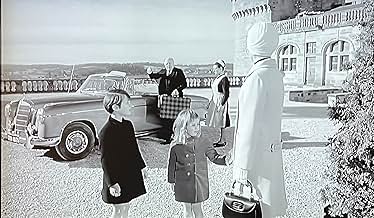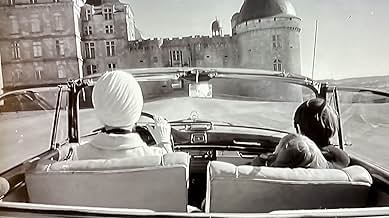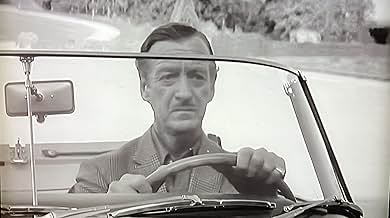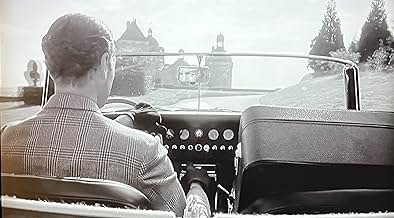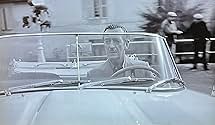IMDb RATING
6.1/10
3.5K
YOUR RATING
Workers employed at a French vineyard quietly follow old pagan rituals that call for the life of the marquis owner to save his crops during dry seasons.Workers employed at a French vineyard quietly follow old pagan rituals that call for the life of the marquis owner to save his crops during dry seasons.Workers employed at a French vineyard quietly follow old pagan rituals that call for the life of the marquis owner to save his crops during dry seasons.
Chris Adcock
- Villager
- (uncredited)
Hyma Beckley
- Villager
- (uncredited)
Olwen Brookes
- Party Guest
- (uncredited)
Featured reviews
Why do the makers of movies very often think that they are better than the author of the original text? A lot of important details from the novel have been simply left out, the structure has been altered, the characters modified. One should really read the novel first to understand the contest.
Historically speaking this film serves as an invaluable precursor to Anthony Shaffer's ingenious THE WICKER MAN, starring Edward Woodward and Christopher Lee. Taken on its own, however, EYE OF THE DEVIL is an effective but wildly uneven film.
The story deals with a wealthy French nobleman (David Niven) who is called back to his ancestral castle when the crops fail. Due to his erratic behavior regarding this summons, wife Deborah Kerr becomes increasingly worried about Niven's safety. Against his orders, Kerr takes her children to his ancestral castle, where she witnesses many strange and eerie religious rites. The question then becomes, will Kerr be able to rescue Niven from a ritual sacrifice, and -- indeed -- does he wish to be saved?
Owing to its erratic production history, it's not surprising that EYE OF THE DEVIL is a bit rough around the edges. The story is obtuse, and the characters under-developed, but director J. Lee Thompson employs an intriguingly arty approach that keeps one alert throughout. Thompson makes excellent use of Ernest Haller's mobil camerawork, most notably in a memorable race-against-the-clock climax. Additionally, the score is excellent, and the cast is well above average for this sort of thing. In the lead roles, Kerr and Niven are effective and restrained, but it is the supporting cast that really impresses: Donald Pleasence, his head shave completely bald, as a sinsiter cleric; David Hemmings as a seemingly evil youth; and especially Sharon Tate as Hemmings' enchantingly sensual/wicked sister.
In the end, EYE OF THE DEVIL cannot be considered a great film. It is, however, an above average diabolical thriller, and as such can be recommended to horror fans. My rating: *** out of ****
The story deals with a wealthy French nobleman (David Niven) who is called back to his ancestral castle when the crops fail. Due to his erratic behavior regarding this summons, wife Deborah Kerr becomes increasingly worried about Niven's safety. Against his orders, Kerr takes her children to his ancestral castle, where she witnesses many strange and eerie religious rites. The question then becomes, will Kerr be able to rescue Niven from a ritual sacrifice, and -- indeed -- does he wish to be saved?
Owing to its erratic production history, it's not surprising that EYE OF THE DEVIL is a bit rough around the edges. The story is obtuse, and the characters under-developed, but director J. Lee Thompson employs an intriguingly arty approach that keeps one alert throughout. Thompson makes excellent use of Ernest Haller's mobil camerawork, most notably in a memorable race-against-the-clock climax. Additionally, the score is excellent, and the cast is well above average for this sort of thing. In the lead roles, Kerr and Niven are effective and restrained, but it is the supporting cast that really impresses: Donald Pleasence, his head shave completely bald, as a sinsiter cleric; David Hemmings as a seemingly evil youth; and especially Sharon Tate as Hemmings' enchantingly sensual/wicked sister.
In the end, EYE OF THE DEVIL cannot be considered a great film. It is, however, an above average diabolical thriller, and as such can be recommended to horror fans. My rating: *** out of ****
Good cast, good director (J. Lee Thompson)...so what went wrong? Despite a sumptuous production and handsome locales, thriller about an ancient French estate needing a human sacrifice to restore life to the dying grape vineyards is frantic and confusing. The editing is such a hodgepodge, it's as though the negative got crammed into a blender. How else to explain the total lack of character content, the muddled continuity, or the perplexing plot itself? Also referred to as "13", the title-switcheroo proved unlucky for everyone, maybe most especially Sharon Tate (who does look gorgeous and has one neat scene where she changes a toad into a dove). Tate wanders through the film in a passive fog, and is later the victim to a whip-snapper; she gets an 'introducing' credit here, just as she did for 1967's "Don't Make Waves", though neither film is memorable nor uses her adequately. Poor miscast David Niven has nasty bags under his eyes, and his repartee with old friend Deborah Kerr (brought in after Kim Novak was either let go or dropped out) has no nuances--they seem like strangers. ** from ****
Okay spooker is missing some important back-story that would make it more compelling. Niven is disengaged in the lead, leaving a slackness to the main thrust of the movie but Deborah Kerr is suitably panicked as the questioning wife. What a supporting cast though! Flora Robson, Edward Mulhare, Emlyn Williams all contribute little bits of color and Donald Pleasance is ideally cast as an ominous presence who keeps popping, up his liquid eyes betraying nothing but giving the viewer the creeps nonetheless. David Hemmings has little to do but stare into the distance and give off an unpleasant vibe which he does well while being disturbing in his beauty. Speaking of beauty, this was Sharon Tate's first big role in her regrettably short career and she gets the corresponding introducing credit , man alive was she breathtaking! She gives an appropriate performance all glacial looks and dreamy line readings, the part doesn't demand more than that. But the camera loved her and when she's on screen you look at no one else, a vital component of a star. Would she have achieved that position? Who knows but the ingredients where definitely there. The black & white photography is most evocative and was a wise choice to set the proper tone for the piece. Not a great film by any means but a decent view near Halloween.
It certainly has all the ingredients to make this a classic, but fails to make it through for me, despite the pretty impressive cast.
It does bring to mind the Deborah Kerr cult movie The Innocents, but doesn't quite get there. All the components are here, but I thought the lack of pacing of the film made this less effective entertainment.
It is interesting nonetheless if you can take the slower pace. The outside shots mostly take advantage of the set location in France in a castle or chateau, which adds to the atmosphere quite well. The film does have the feel though of being filmed the earlier 1960's, rather than in the second half, with the camera angles etc i.e. close up of the actor to the side of the shot with the action/plot developing in the distance. It's shot in black and white which works very well, just at this time in cinema, there was the colour explosion going on.
The two "youngsters" here, David Hemmings (died blond hair) and Sharon Tate certainly look good, which is handy, as they do not appear to have many lines. They mostly go for the quiet manacing look school of acting here.
For those who like a bit of S&M, Sharon Tate gets a whipping and seems to like it, but don't expect too much, and that includes any erotic scenes or nudity. Just as well, as they are not needed, although it may have made the film slightly more interesting if tastefully done.
Sharon goes through the film looking like a model here in nearly all of her screen time. Donald Pleasance is Donald Pleasance who gives most of his best acting with his eyes, and does not have the lines or role to make his performance more memorable, which is a shame. As to David Niven's performance, it was good enough, but no particular plaudits from me (or criticism). Deborah Kerr is quite good, and is trying reasonably hard I thought, as did Flora Robson.
It's a 60's, B/W film, driven by a pagan plot with the usual accoutrement's (monks in hoods etc), and if that is your thing then give it a go. Not an out and out classic, but is worthy of being mentioned with the best of this genre, and more as an interesting flawed cult movie for horror fans.
It does bring to mind the Deborah Kerr cult movie The Innocents, but doesn't quite get there. All the components are here, but I thought the lack of pacing of the film made this less effective entertainment.
It is interesting nonetheless if you can take the slower pace. The outside shots mostly take advantage of the set location in France in a castle or chateau, which adds to the atmosphere quite well. The film does have the feel though of being filmed the earlier 1960's, rather than in the second half, with the camera angles etc i.e. close up of the actor to the side of the shot with the action/plot developing in the distance. It's shot in black and white which works very well, just at this time in cinema, there was the colour explosion going on.
The two "youngsters" here, David Hemmings (died blond hair) and Sharon Tate certainly look good, which is handy, as they do not appear to have many lines. They mostly go for the quiet manacing look school of acting here.
For those who like a bit of S&M, Sharon Tate gets a whipping and seems to like it, but don't expect too much, and that includes any erotic scenes or nudity. Just as well, as they are not needed, although it may have made the film slightly more interesting if tastefully done.
Sharon goes through the film looking like a model here in nearly all of her screen time. Donald Pleasance is Donald Pleasance who gives most of his best acting with his eyes, and does not have the lines or role to make his performance more memorable, which is a shame. As to David Niven's performance, it was good enough, but no particular plaudits from me (or criticism). Deborah Kerr is quite good, and is trying reasonably hard I thought, as did Flora Robson.
It's a 60's, B/W film, driven by a pagan plot with the usual accoutrement's (monks in hoods etc), and if that is your thing then give it a go. Not an out and out classic, but is worthy of being mentioned with the best of this genre, and more as an interesting flawed cult movie for horror fans.
Did you know
- TriviaThis movie spent a long time on the shelf. Filming was completed in the early part of 1966, but its American release was not until late 1967, and its British one not until the spring of 1968. David Hemmings made this movie before his breakthrough role in Blow-Up (1966), and it is quite possible that the great (and unexpected) popularity of that movie was what finally pushed MGM into releasing this one. Many commented with surprise on the smallness of Hemmings' role - it is likely that his special billing, along with that of Sharon Tate, was an afterthought to disguise the fact that they had supporting parts. Although this movie was supposed to launch Tate, she had, because of its protracted shelf-life, already been seen in Comment réussir en amour sans se fatiguer (1967), which she had made subsequently. That movie has a special "introducing" credit for her as a result.
- GoofsDavid Niven's character, Philippe, goes to a vineyard to inspect grapes, wearing a blazer with a button-down oxford underneath. After a cutaway scene to a different character, the view returns to Philippe in the vineyard. He is still wearing the same oxford but now he has a covering sweater-vest on instead of the blazer.
- Quotes
Philippe de Montfaucon: Believe it, Catherine.
Catherine de Montfaucon: I just told you, I don't!
Philippe de Montfaucon: Believe it. Believe it. Believe it. Or leave here.
- Crazy creditsThe Turner print has the main title as "Eye of the Devil" but the ending credit lists the title as "13".
- Alternate versionsThe "Turner" print uses "Eye of the Devil" as the main title; but, the end credit lists the title as "13". This print has a running time of 95 minutes.
- ConnectionsEdited into Inside the Manson Gang (2007)
Details
- Release date
- Countries of origin
- Language
- Also known as
- L'oeil du malin
- Filming locations
- Château de Hautefort, Dordogne, France(castle-exteriors)
- Production company
- See more company credits at IMDbPro
Box office
- Budget
- $3,000,000 (estimated)
- Gross worldwide
- $4,966
- Runtime1 hour 36 minutes
- Color
- Aspect ratio
- 1.66 : 1
Contribute to this page
Suggest an edit or add missing content



